
I came to write it because I like the Folia theme so much,
and I thought I would like to have a version that I could play and that
went on, at a fairly fast speed, for several minutes. Since the only instrument
I play (and the only one I compose for) is the recorder, I made this five-part
version for the recorder consort of which I am a member, The Reluctant Consort.
After the statement of the theme in the plainest five-part version possible,
eleven variations follow, the main interest moving from one voice to another.
To conclude, two of the variations are repeated. I mostly omitted bar 16
so that the music would continue driving along relentlessly. That's the
way I like La Folia to sound.
Although it has had a number of public performances, it has never been published
or recorded. Anyone who would like more information can contact me by
email: lance.eccles@mq.edu.au.
| Theme of Variations on La Folía | © Eccles, reproduced with permission |
|---|---|
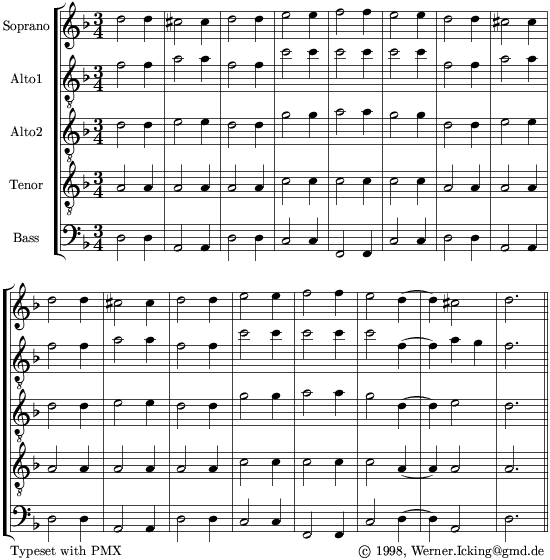 |
|
- Eccles, Lance
- Published by ERTA e.V. European Recorder Teacher Association
- You can buy the score from Edition Walhall – Verlag Franz Biersack in Magdeburg.http://www.edition-walhall.de/
- Published in 2005 (with some minor adaptions made in 2002 by Lance Eccles). Rights for publication by Eccles.
- Score 8 pages and parts 10 pages
- Publishers No. Flautando Edition FE A-076 Manuskriptesammlung, publication 6.2005
- Details of recorder music Lance Eccles has published can be found at Orpheus Music: http://www.orpheusmusic.com.au/
- Sydney Conservatorium of Music's recorder section of the Early Music Ensemble
- Published at YouTube by Tim Payne 6 June 2015
- Performied for the Ambassador of Portugal and the accompanying consulate and their guests.
- Duration: 5'30"
- Recording date: May 15, 2015 at the Sydney Conservatorium of Music's Verbrugghen Hall.
Despite the prominent mentioning of the Folia-theme in the announcement, I could only hear the later Folia-theme once as played by the violin as in the sound fragment.
 |
Duration: 1'26", 1353
kB. (128kbs, 44100 Hz) |
In the announcement of the program was written:
Die neue Konzert- und Kongresshalle in der alten schwedischen Universitätsstadt Uppsala ist ein eigenwilliges Gebäude. Das im September 2007 eröffnete Kulturzentrum liegt mitten in der Stadt und lädt mit drei unterschiedlich großen Konzertsälen, mit Konferenzräumen und einer großen Ausstellungsflächen zu vielfältiger Nutzung ein. Der große Konzertsaal, aus dem dieses Euroradio-Konzert live übertragen wird, fasst etwa 1.150 Zuschauer und ist nach neuesten Erkenntnissen im Bereich der Akustik gebaut. Hier finden nicht nur klassische Konzerte statt, sondern er ist auch für Pop-. Jazz und Folkkonzerte geeignet. So erklingt heute skandinavische Folk- und Tanzmusik gespielt von sieben der bekanntesten schwedischen Musiker in diesem Genre. hr2-kultur überträgt das Konzert im Rahmen des Euroradio-Schwerpunkts „Klassik trifft Volksmusik“.
- Göran Maansson (recorder), Lars Holm (accordeon), Fredrik
Gille (percussion, n.n. guitar), Johan Hedin (violin),
Mikael Marin (alt violin), Mats Olofsson (cello)
- Broadcasted by the Swedish radio in a Eurovision live broadcasting 'Klassik trifft Volksmusik'
- Duration: 55'13"
- Recording date: February 11, 2008 from the Konzert- und Kongresshalle, Uppsala, Sweden
Text in French |
Text in English |
On vit sortir d'une grotte profonde |
From a deep cave were seen to appear |
- Froment, Louis de (conductor) Lefort, Bernard (baritone), Ales, Georges ((violin), Doukan, Pierre (violin), Lanhuite, Pierre (viola), Albin, Roger (violoncello) "Werner Egk, Die Zaubergeige, La Tentation de Saint Antoine"
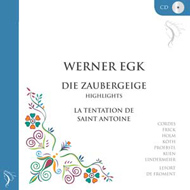
Froment, Louis de (conductor)
Duration: 2'17"" direct link to YouTube
© 2012 by Magdalen, a division of Metronome recordings mono- Title: La tentation de Saint Antoine, after eighteenth Century airs and verses by Michel Jean Sedaine. Baritone version. Title track: On vit sortir (Des Folies d’Espagne)
- Released 2012 by Magdalen, a division of Metronome recordings mono compact disc
- Duration: 2'17"
- Recording date: Recording issued in 1956 in Mono. First time on CD
- Koeckert Quartett, strings of the Bavarian Radio Symphony Orchestra
and Baker, Janet (alt)
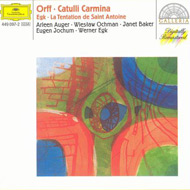
Paul Griffiths wrote for the slipcase:
La Tentation de Saint Antoine, a concert work for contralto and string quartet written in 1945 (and adapted for contralto, quartet and string orchestra in 1952), stands therefore rather apart from his main output in its genre, though not in its ironic tone. According to its title-page, the piece is 'based on airs and verses of the 18th century, so that the demons besetting the saint wear curiously charming masks out of ancient régime pastoral, and the apocalyptic uproar mentioned in the first song is rendered by the musical means of a classical cantata. There is room, though, for Egk's playful music personality to exert itself, rather in the manner of Stravinsky's in Pulcinella. The vocal lines seem to have been kept pretty much intact, if rhythmically altered, but the strings almost always used to provide homogeneous textures, are in a spikier harmonic world, and Egk evidently revelled in the inappropriateness of his chosen airs, which often have a nursery-rhyme simplicity, to the expression of spiritual crisis. In doing so, however, he was contributing to the strong tradition of comedy in the Saint Anthony story, a tradition which deals with the Last Things not as the dire threat Everyman felt himself to face, but as so much absurdity.
- Title: On vit sortir d'une grotte profonde (Air: Des folies d'Espagne)
- This work for contralto and string quartet written in 1945 was adapted for contralto, string quartet and string orchestra in 1952
- Released 1971 by Deutsche Grammophon, digitally remastered 1990 compact disc 449 097-2
- Duration: 2'14"
- Recording date: November 1965 in Ufa-Tonstudio Berlin
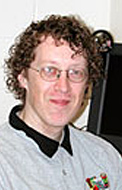
 |
Duration: 3'05", 2900
kB. (128kbs, 44100 Hz) |
 |
The complete Ma Follia, 15 pages in pdf-format, 1.1
MB © Victor Eijkhout 2006, used with permission |
I had come across La Follia as the name of an early music ensemble in Austin,
TX, where I live. When I looked up the history of that name I started thinking
about writing my own variations. The direct reason for doing so was the monthly
competition on the kvraudio.com web site. Ma Follia, or rather the recording
of it, was my entry for October 2006. The limit on competition entries is 2
minutes, so every variation was really only the first half of the theme, with
the exception of the last variation which returns to the tonic.
Since then, I've extended it to about 3 minutes, by supplying the second half to some variations. Since I find simple repetition a bit boring, the second halves bring in new material. I do this by using double-choral effects between A1,A2,T1 and A3,A4,T2. In the first variation the second choir simply thickens up the harmony, but in the second they play polyrhythmically 4-over-3, and in the third variation there is a little hocket passage between the two choirs. After two half variations with soprano and alto solo parts, there is a full variation with a swinging tenor solo, over which in the second half the higher voices quote a jazz tune.
True to tradition, this set has a variation in the major key, but instead of simply converting the chords to major, I wrote a brief passages of somewhat wild variations. Ma Follia ends with a dense texture of very traditional harmonies, played by the full ensemble, with sopranino and gar klein joining in on the second half.
- Eijkhout, Victor
- Recorders: small, sopranino, 2 sopranos, 4 altos, 2 tenors, bass
- Duration: 3'05"
- Recording date: November 2006 (original version September 30)
- More about the Ma Follia composition at the Petrucci Music Library http://imslp.org/wiki/Ma_Follia_(Eijkhout,_Victor) and about dutch rural folk songs http://imslp.org/wiki/Oude_en_Nieuwe_Hollantse_Boerenlieties_en_Contredansen_(Anonymous)
- More about Victor Eijkhout at the page http://www.eijkhout.net (including the seperate parts for instruments of the sheet music)
These Folia-variations are an enumeration of two pieces: an anonymous Spanish manuscript for harp and the manuscript by Lucas Ruiz de Ribayaz with a nice intro.
- Eilander, Maxine (Spanish and Italian harps, Stephen Stubbs: baroque guitar) 'Teatro Lirico'
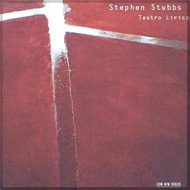
- Released February 2006 by ECM New Series 1893 4763101
- Duration: 3'32"
- Recording date: February 2004 in Propstei St. Gerold
- See also the page Recommended Folia-recordings
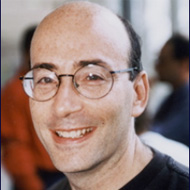 "Variations on La Follia" were composed in 2011. It is approximately 18 minutes long. It was composed for Parthenia, a consort of viols (1 treble, 1 tenor, 2 bass).
"Variations on La Follia" were composed in 2011. It is approximately 18 minutes long. It was composed for Parthenia, a consort of viols (1 treble, 1 tenor, 2 bass).World Premiere performance by Ensemble Parthenia, October 22, 2011 at Picture Ray Studio in Manhattan
|
Variations on La Follia began, appropriately enough, as a kind of a joke.
I first heard Parthenia when they performed at my friend Jacqueline Horner-Kwiatek’s wedding. I
spent most of that lovely afternoon sitting as close as possible, listening to them play Lawes and
Purcell and Jenkins, completely enthralled. Later, Jacqui suggested that I might want to write a
piece for her to sing with Parthenia. I immediately agreed. I had worked with viols before, on the Voices of Light project (which Jacqui, a member of Anonymous 4, had sung countless times). I
loved the sound of viols.
During the first part of 2010, I set several poems by an Irish poet (Jacqui hails from the Emerald
Isle) but try as hard as I could, the music kept coming out as modern string quartet music, not viol
music. Violins, viola, and cello seem related and similar to viols but are actually entirely different.
What is idiomatic and simple for the violin is not necessarily so for the treble viola, for example,
and the sound of the ensemble is very different: a consort of viols has a haunting, mysterious
sound, an evocative wistfulness that is deeply appealing to me.
In short, I had misjudged how very unique viols were and so, I put aside some 30 minutes of music
and undertook a deep immersion in viol technique and repertory. I listened to hours of recordings
and studied dozens of scores, often note by note to understand the technique and fingerings.
One day, on a lark, I started to play around with La Follia, that ancient tune that attracted so many
composers including Marais, Vivaldi, and CPE Bach. In my spare time, I’d write a variation or two.<
They sounded like they’d be fun to play so I wrote to Lisa Terry and suggested she hear all the new
music I’d been working on, the LaFo - as we called it - as well as a some short etudes. We spent a
very long afternoon going through it all and we both laughingly agreed that it that it was high time
someone wrote a new set of “La Follias.”
And so, what began as a diversion became a major compositional focus for a while. All the same,
my piece was never intended to be serious competition to the La Follia masterpieces of the
Baroque and Renaissance. Rather, it’s a collection of “follies,” with (hopefully) at least a tiny bit of humor. For example, there’s a variation in which one of the bass viols begins some elaborate
passagework, accompanied by the other three players. Then it gets a little too florid and deliberately
goes on too long until it becomes obnoxious. In exasperation, the other players finally shut up the
by-now nearly manically out of control bass viol.
William Faulkner wrote “the past is never dead, it's not even past.” While viols have a long
tradition, and an awesomely beautiful repertory,there always will be more music to write. The
challenges composers have today are the eternal problems, the same ones that Sainte-Colombe and
Marais and Purcell and Jenkins and Lawes all grappled with: how to compose for these gorgeous,
evocative instruments and how to honor and (hopefully) extend a great repertory with new music
that aspires to speak, with some fluency and eloquence, the language of viols.
I want to take this opportunity to thank Lisa Terry and the rest of Parthenia for their enthusiasm and
dedication to viol music. It has been a great pleasure to work with them and I hope to write much
more music for these instruments.
- Einhorn, Richard
- Published by Richard Einhorn Music (ASCAP) and can be purchased by writing to richardeinATmac.com
- Duration: approx. 18 minutes
- Number of pages and parts: Score: 27 pages of full score, Parts: 4 parts (1 treble, 1 tenor, 2 bass viols)
- You can find more information about the composer at http://www.richardeinhorn.com/
- Parthenia (Beverly Au, Lawrence Lipnik, Rosamund Morley and Lisa Terry)
- Published by Parthenia at YouTube February 2nd, 2012
- Duration: 18'37"
- Recording date: October 22, 2011 at Picture Ray Studio in Manhattan, USA
- More information about Parthenia at http://www.parthenia.org/
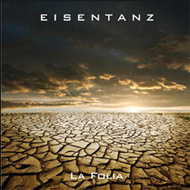
La Folia by Eisentanz
|
- Eisentanz (Jean-Claude Horlacher)
- Released 2013 by Ng-Productions single in mp3-format
- Duration: 4'41"
- Recording date: 2013
Dedicated to Hans Werner Henze
- Instrumentistas del III Festival Cantiere d'Arte de Montepulciano
- Released 1980 by Suvini Zerboni, Milán
- Duration: 10'00"
- Recording date: August 9, 1978 at the 3rd Festival Cantiere d’Arte de Montepulciano, Teatro Poliziano, Montepulciano,Italy
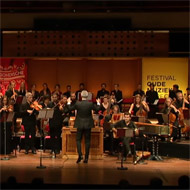
Daucé made a musical reconstruction of the dance, divided into four parts and with a libretto by Isaac de Benserade. The Folies d'Espagne is not mentioned in the program, yet it is quoted briefly in the program at 32'54" - 34'08" in the YouTube registration with the slow theme (sarabande) and one quick variation including trumpets and castagnets.
- Ensemble Correspondances conducted by Sébastien Daucé
- Performed at the Festival of Early Music, Utrecht, The Netherlands, 28 August 2018
- Broadcasted at YouTube by AVROTROS 29 August, 2018 https://www.youtube.com/watch?v=JNqcu-mogTs&t=713s
- Duration: 1'14"
- Recording date: August 28, 2018 in Tivoli/Vredenburg, main podium (Grote Zaal).

A Folia with unusual instruments and a reference to the most famous Folia of Arcangelo Corelli.
Follia dell'Arcangelo |
- Oni Wytars (with Marco Ambrosini: Viola d'amore a chiavi (nyckelharpa), Katharina Dustmann: Percussion,
Peter Rabanser: Baroque Guitar, Michael Behringer: Organ, Jule Bauer: Viola d'amore a chiavi (nyckelharpa)
- Published at YouTube April 3, 2014 by oniwytars, production WDR3
- Duration: 2'59"
- Recording date: December 18, 2013 in Bielefeld, Germany
- See also the page recommended recordings
- The website of Oni Wytars http://www.oniwytars.de/
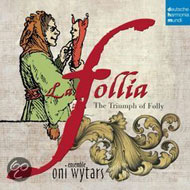 The tune follows the score of Vivaldi's Follia in an arrangement for the recorder instead of the violin in the lead. However there is a brand new vocal part in between partly based upon Vivaldi but in a more southern Italian way. The text refers to the lietral meaning of the word Folia.
The tune follows the score of Vivaldi's Follia in an arrangement for the recorder instead of the violin in the lead. However there is a brand new vocal part in between partly based upon Vivaldi but in a more southern Italian way. The text refers to the lietral meaning of the word Folia.
- Ensemble Oni Wytars 'La Follia, the triumph of Folly'
- Title: "Sontata "La Folia"(Vivaldi-Ambrosini)
- Released 2013 by Deutsche Harmonia Mundi compact disc 88765449782
- Duration:10'01"
- Recording date: October 1-3, 2011 in Kurtheater, Bad Kissingen, Germany
- See also recommended recordings
La Folie D' Espagne by Erna Schmidt |
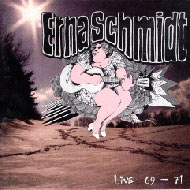
- Erna Schmidt: Hubert Stütz (guitar), Hartmut Mau (flute, sax, oboe,
ocarina), Walther Laible (bass), Wolfgang Mathias (drums and percussion)
'Live '69-'71'
- Released 2000 by Garden of delights compact disc CD 048
- Duration: 7'02"
- Recording date: recorded live over the years 1968-1971 (though mostly from 1970)
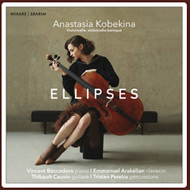
- Kobekina, Anastasia (violoncello)
- Rweleased August 2022 Mirare label
- Duration: 5'40"
- Recording date unknown
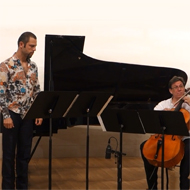
Sopra la Folia by Thierry Escaich |
- Strauss, Michel (cello) Pollak, Max (tap/body percussion)
- Released 2014 at YouTube
- Duration: 8'31
- Recording date 29 August 2014 at Musique de Chambre àGiverny
- Link to YouTube https://www.youtube.com/watch?v=XLXuihPLmYI
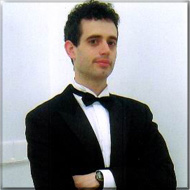 The piece was commissioned by Larry Harper for Concert Band (wind orchestra) and the premiere is planned for March 2007.
The piece was commissioned by Larry Harper for Concert Band (wind orchestra) and the premiere is planned for March 2007.Pablo Escante wrote about this composition:
Well, I had a German girlfriend (professional singer) who was crazy about baroque music and because she died very young (28 years old)
I decided to dedicate one of my compositions to her memory and picked for that the very baroque-like Folia theme.
I knew this theme well because I played several sets of variations
by C.P.E.Bach, another Bach son and A. Scarlatti myself and was familiar with versions of Pasquini, Vivaldi, Corelli and Rachmaninoff.
I checked at the internet and found your web-site. I noticed that there was not yet a set of variations made for
Concert band.
Then I got this commission from Larry Harper in Wisconsin and voila.....I waited till I finished the whole piece to inform you that
a new set of variations was born. The composition is a theme with 8 variations plus a finale (a big fugue mixed in rondo form)
and the entire lenght is 15 minutes.
- Escande, Pablo
- To be published by Ed. Molenaar, The Netherlands
- Duration: approx. 15 minutes
- Number of pages and parts: unknown
- You can find more information about the composer at http://www.pabloescande.net

Variaciones Progresivas Sobre las Folías de España Op. 8 |
- Espií, Fernando (guitar) 'Espí X Espí'
- Released 2016 by label '6x8'
- Duration: 8'40
- Recording date unknown
- Link to YouTube https://www.youtube.com/watch?v=GKdIV91E16E
 Eli wrote theme and 15 variations on the Folia including an intermezzo in quite a conventional way. Especially in the
intermezzo but also in a couple of variations the calm balanced way of piano-playing in the style of George Winston
is echoing in my mind.
Eli wrote theme and 15 variations on the Folia including an intermezzo in quite a conventional way. Especially in the
intermezzo but also in a couple of variations the calm balanced way of piano-playing in the style of George Winston
is echoing in my mind.Clear lines without much tension or friction for a relaxed smooth journey into La Folia.
 |
Duration: 7'05", 8.6 MB. (128kbs, 44100Hz) |
I had thought to submit my folia, but didn't think my work
really merited inclusion. Besides, there is always one more variation that
could be tacked on, so I fear it may never be "finished."
I would agree with the assessment that it's a very convential approach;
I'm a very conventional person, and I have only a beginning/student level
of composition competence, so it only stands to reason. I'm gratified to
hear that you found it listenable, and I'll gladly submit whatever information
you need to include it in the Folia museum.
I think of my folia as a continual work in progress, so fixing the date
may be difficult. I wrote the first variations sometime in 2000, perhaps;
at any rate, it was not long after I discovered the Folia Home Page for
the first time. I had already heard of the folia in college, where I took
one year of basic music theory, and I've always admired it: Simple and elegant,
yet robust and flexible, with a certain ancient flavor. One day a friend
heard me playing a simple variation on the church piano after services and
asked me what I was playing. I couldn't remember the name of the theme,
but I remembered that Corelli and Salieri both produced variations. In looking
for the answer to my friend's question, I stumbled upon the Folia Home Page
and I spent an evening reading it all. After reading the history of the
folia and looking at some of the examples of the early and late folias,
I decided that writing my own (modest) set of variations would be an interesting
problem to tackle.
I generally write music not for the passion of the creative or artistic
process, but as a sort of relaxing mind game.
Why write a folia? I write variations on the folia for the same reason
that I write programs to automatically generate music from words and text:
It's an interesting problem, and that's the sort of thing that makes me
happy. The folia represents to me a sense of order. My approach to the folia
is conventional, because I see it as a convention: It's so pervasive and
flexible that it's like a musical institution, almost a fact of nature.
It's simple, instantly recognizable, harmonious, and balanced, but can be
employed in all sorts of novel ways. Because of this, the folia has a calming,
reassuring effect on me -- as if it reminds me that there can be order to
the universe after all, even when it doesn't seem like it. So whenever I
feel particularly chaotic, I can always ease my troubled mind through the
exercise of applying a new figuration or formula to the pattern folia to
see what new orders and sub-orders are produced by the combination.
I hope that doesn't seem overly pretentious. In fact, it's quite simple:
Some people have a brandy and a cigar to relax, or curl up with a good book,
or sit down to add some more rigging to their scale model of a Spanish galleon.
I write music. It's nice, clean hobby.
- Evans, Eli T. (piano/midi-sequencer)
- Released 2004 by Eli T. Evans at his website
- Duration: 7'05"
- Recording date: 2004 in Ferndale, Washington, USA
- More about the music of Eli T. Evans at his Blog-page http://www.supakoo.com/eli/default.asp?p=Music
